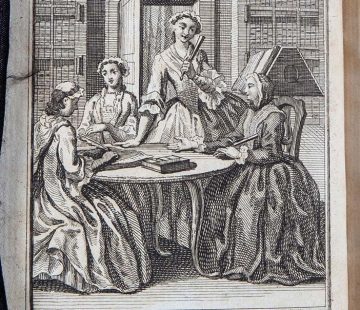
Criticism on Haywood’s Female Spectator: An Overview
Haywood criticism saw a boon in the late twentieth century after feminists unearthed her. Only since about 2010, though, has her Female Spectator garnered the serious attention of scholars, despite its historically significant status as the first periodical by and for women and despite the fact that it was Haywood’s most popular work during her lifetime. Previously, scholars understood The Female Spectator as Haywood’s “testament to her shift away from the audacity that distinguished her earlier writings, toward a more sober didacticism allegedly characteristic of her later years as a writer” (Girten, p. 56). I join Girten in countering that assumption, participating in the newer critical framework to reveal The Female Spectator as subtly subversive. Along with Kathryn King’s highly lauded Political Biography of Eliza Haywood and Lynn Wright and Donald Newman’s Fair Philosopher: Eliza Haywood and The Female Spectator, I forward the persona of Haywood, even “late” Haywood, as a political and philosophical writer, wisely navigating the circumstances afforded her as one of the few, and the most prolific (in terms of genre), 18th-century women writers. In 1786, the first female philosopher was recognized by the British Royal Society–Caroline Herschel, whose discovery Frances Burney termed “the first lady’s comet” (Girten, p. 60). Haywood and her periodical’s “correspondents” were dubbed the “fair philosophers” 42 years before that, in The Gentleman’s Magazine (Fair Philosopher 15). While “other texts by women from the same period are even more overt in their challenge to gender disparity” (Girten, p. 70)–including Haywood’s younger self–The Female Spectator persuades in a different, perhaps more politically savvy and subtle, way.
Cheryl Turner has examined how women writers benefited from sustained relationships with publishers, and scholars have focused on Haywood’s relationship with her frequent publisher late in her career, Thomas Gardner, but there exists no sustained study on Haywood’s relationship with her patrons, such as Juliana Colyear, the duchess of Leeds to whom she dedicates the Female Spectator project at its onset. Sarah Prescott writes that “Eliza Haywood’s participation in and use of patronage has often been overlooked in favour of recent assessments of her as working almost exclusively in the world of the booksellers and printers” (p. 116), and King writes that “further research on Haywood’s dedicatory practices over the long trajectory of her writing life is needed before we can draw conclusions about the relationship between Haywood’s strategies as an author and the forms of patronage available to her” (Fair Philosopher, p. 117). Haywood’s dedication of The Female Spectator to Colyear has been described as a continuation of Haywood’s “Hanoverian and pro-Marlborough sentiments” and resultant fascination” with Sarah Churchill and her family (Selected Fiction xviii). Was Haywood successful in receiving payment from Colyear and her cousins, to whom other volumes were dedicated? If so, how much money did she receive? What was the extent of her relationship with these women, if any other than the solicitation of funds for her writing? How might it have been affected with her later, morphing, non-patriotic targets of patronage—even within the same two-year period for The Female Spectator itself? What was the effect on readers, that the periodical boasted Colyear’s name in the introductory pages? Is Haywood referring to Colyear’s second husband in the dedication, ignoring her first husband, Peregrine Osborne, the duke of Leeds? These questions are not yet answered.
Works Cited
Fair Philosopher: Eliza Haywood and The Female Spectator, eds. Lynn Wright and Donald Newman. Lewisburg, Bucknell University Press, 2006.
Girten, Kristin. “Unsexed Souls: Natural Philosophy as Transformation in Eliza Haywood’s Female Spectator Author(s).” Eighteenth-Century Studies, vol. 43, no. 1, 2009, pp. 55-74.
Haywood, Eliza. The Female Spectator. London, T. Gardner, 1745.
Ingrassia, Catherine. “Queering Eliza Haywood.” Journal for Early Modern Cultural Studies, vol. 14, no. 4, 2020, pp. 9-24.
King, Kathryn. A Political Biography of Eliza Haywood. New York, Routledge, 2016.
— “Editing Eliza Haywood’s The Female Spectator (1744–1746): Making (and Unmaking) a Periodical ‘for Women,’” Editing Women’s Writing, 1670-1840, eds. Amy Culley and Anna Fitzer, Routledge, 2017, pp. 29-42.
Koon, Helen. “Eliza Haywood and the Female Spectator.” Huntington Library Quarterly, vol. 42, no. 1, 1978, pp. 43-55.
Prescott, Sarah. Women, Authorship and Literary Culture 1690-1740. Springer, 2003.
Selected Fiction and Drama of Eliza Haywood (Women Writers in English 1350-1850), ed. Paula Backscheider. Oxford University Press, 1999.

